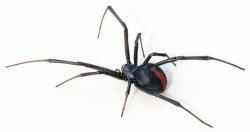Black Widow Spider
 The black widow spider is present across the entire United States. This spider is found outdoors in all kinds of protected areas. Around homes, it lives in garages, cellars, furniture, ventilators, rain spouts, gas and electric meters and many other undisturbed places. Like most spiders, the black widow is shy and retiring. People are bitten when they accidentally disturb a hidden spider or its web. Females are usually jet black in color. The lower side of their rounded abdomen is marked by two reddish triangles resembling an hourglass in shape. In some individuals the markings may be irregular, spot-like or even absent. The black widow’s overall length averages about 1 ½ inches. The black widow has eight eyes in two rows, which is a common pattern in many spiders. Gravid females lay their eggs singly in a loosely woven cup of silk. The oval egg sacs are about ½ inch long. These egg sacs hold from 25 to 900 or more eggs, which undergo an incubation period of about 20 days. The spiderling’s usually stay near the egg sac for a few days after they emerge. Cannibalism is prevalent during this time. Eventually the surviving spiderling’s disperse by means of small silk threads. When they are about one-third grown they establish themselves in some protected place and construct loosely woven webs. The spiders usually remain in their webs for the rest of their lives. As they mature they extend their webs and capture progressively larger prey. Males eventually leave their webs to find females for mating. The females sometimes eat the males after mating; this habit is what gave the black widow their name. A black widow bite feels like a pin prick and sometimes is not even felt. Usually, a slight local swelling and two red spots surrounded by local redness indicates the location of the bite. Pain becomes intense in 1 to 3 hours and may continue for up to 48 hours. Symptoms include abdominal pains, rise in blood tremors, loss of muscle tone and vomiting. The toxin also causes breathing difficulties and sometimes unconsciousness. Mortality estimates from a black widow spider bite is less than 5 percent.
The black widow spider is present across the entire United States. This spider is found outdoors in all kinds of protected areas. Around homes, it lives in garages, cellars, furniture, ventilators, rain spouts, gas and electric meters and many other undisturbed places. Like most spiders, the black widow is shy and retiring. People are bitten when they accidentally disturb a hidden spider or its web. Females are usually jet black in color. The lower side of their rounded abdomen is marked by two reddish triangles resembling an hourglass in shape. In some individuals the markings may be irregular, spot-like or even absent. The black widow’s overall length averages about 1 ½ inches. The black widow has eight eyes in two rows, which is a common pattern in many spiders. Gravid females lay their eggs singly in a loosely woven cup of silk. The oval egg sacs are about ½ inch long. These egg sacs hold from 25 to 900 or more eggs, which undergo an incubation period of about 20 days. The spiderling’s usually stay near the egg sac for a few days after they emerge. Cannibalism is prevalent during this time. Eventually the surviving spiderling’s disperse by means of small silk threads. When they are about one-third grown they establish themselves in some protected place and construct loosely woven webs. The spiders usually remain in their webs for the rest of their lives. As they mature they extend their webs and capture progressively larger prey. Males eventually leave their webs to find females for mating. The females sometimes eat the males after mating; this habit is what gave the black widow their name. A black widow bite feels like a pin prick and sometimes is not even felt. Usually, a slight local swelling and two red spots surrounded by local redness indicates the location of the bite. Pain becomes intense in 1 to 3 hours and may continue for up to 48 hours. Symptoms include abdominal pains, rise in blood tremors, loss of muscle tone and vomiting. The toxin also causes breathing difficulties and sometimes unconsciousness. Mortality estimates from a black widow spider bite is less than 5 percent.
Brown Recluse Spider
The brown recluse spider inhabits many southern and Midwest states, and it often lives around human dwellings. Brown recluse spiders are found in bathrooms, closets, under and around furniture, behind baseboards, door facings, corners and crevices along with many other protected areas. They also like cluttered cellars and garages and are most active at night. Many of the bites people have received from this spider are when they entrap the spider, such as rolling over on it when they sleep, or placing on a piece of clothing that has been undisturbed for a long period of time. The brown recluse spider is a non aggressive spider that spins a white or grayish, nondescript web. Its body and legs together cover about the same area as a quarter or half dollar, and the body is only about ¼ to ½ inch long. The coloring of the recluse varies from an orange-yellow to dark brown or almost black. The most distinguishing characteristics are the spider’s eyes and back markings. It has six eyes in three pairs arranged in a semicircle on the forepart of the head. This eye pattern is uncommon in spiders and will help eliminate many species suspected to be brown recluse spiders. The eyes also form the base of a violin-shaped marking on the back. The neck of the “violin” is formed by a distinct, short, median groove. The effects of a brown recluse spider bite may be immediate or delayed, depending upon the amount of venom injected and the victim’s sensitivity. The bite usually causes a stinging sensation and then intense pain. Within 24 to 36 hours a systemic reaction may occur, characterized by restlessness, fever, chills, nausea, weakness and joint pain. The bite also produces a small blister surrounded by a large congested and swollen area. The venom usually kills the affected tissue, which gradually sloughs away and exposes underlying tissues. The edges around the wound will thicken, while the exposed center fills with dense scar tissue. Healing may take 6 to 8 weeks, leaving scars of various sizes.
